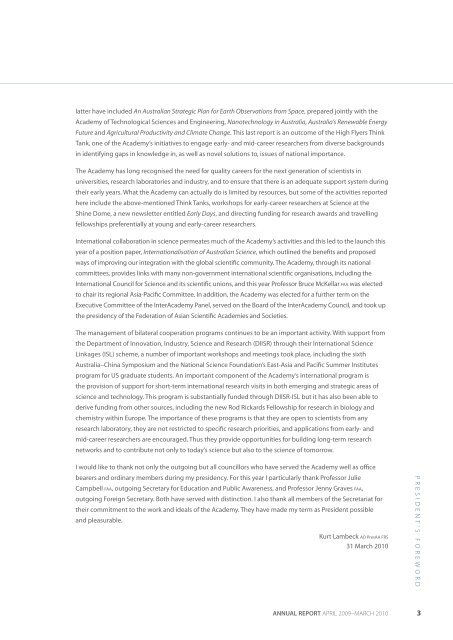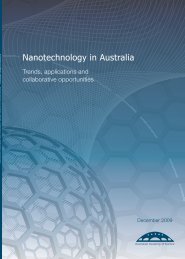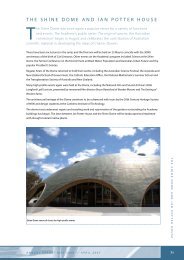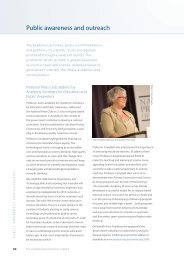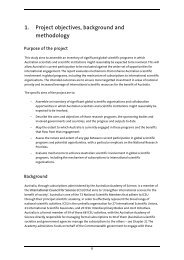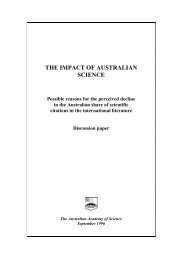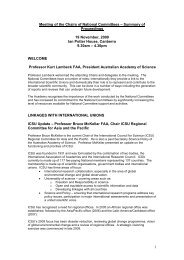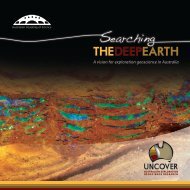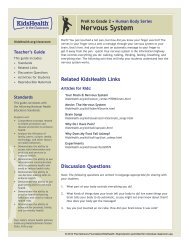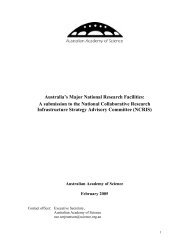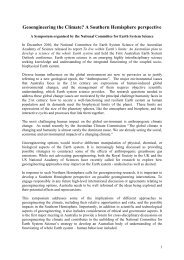ANNUAL REPORT - Australian Academy of Science
ANNUAL REPORT - Australian Academy of Science
ANNUAL REPORT - Australian Academy of Science
Create successful ePaper yourself
Turn your PDF publications into a flip-book with our unique Google optimized e-Paper software.
latter have included An <strong>Australian</strong> Strategic Plan for Earth Observations from Space, prepared jointly with the<br />
<strong>Academy</strong> <strong>of</strong> Technological <strong>Science</strong>s and Engineering, Nanotechnology in Australia, Australia’s Renewable Energy<br />
Future and Agricultural Productivity and Climate Change. This last report is an outcome <strong>of</strong> the High Flyers Think<br />
Tank, one <strong>of</strong> the <strong>Academy</strong>’s initiatives to engage early- and mid-career researchers from diverse backgrounds<br />
in identifying gaps in knowledge in, as well as novel solutions to, issues <strong>of</strong> national importance.<br />
The <strong>Academy</strong> has long recognised the need for quality careers for the next generation <strong>of</strong> scientists in<br />
universities, research laboratories and industry, and to ensure that there is an adequate support system during<br />
their early years. What the <strong>Academy</strong> can actually do is limited by resources, but some <strong>of</strong> the activities reported<br />
here include the above-mentioned Think Tanks, workshops for early-career researchers at <strong>Science</strong> at the<br />
Shine Dome, a new newsletter entitled Early Days, and directing funding for research awards and travelling<br />
fellowships preferentially at young and early-career researchers.<br />
International collaboration in science permeates much <strong>of</strong> the <strong>Academy</strong>’s activities and this led to the launch this<br />
year <strong>of</strong> a position paper, Internationalisation <strong>of</strong> <strong>Australian</strong> <strong>Science</strong>, which outlined the benefits and proposed<br />
ways <strong>of</strong> improving our integration with the global scientific community. The <strong>Academy</strong>, through its national<br />
committees, provides links with many non-government international scientific organisations, including the<br />
International Council for <strong>Science</strong> and its scientific unions, and this year Pr<strong>of</strong>essor Bruce McKellar FAA was elected<br />
to chair its regional Asia-Pacific Committee. In addition, the <strong>Academy</strong> was elected for a further term on the<br />
Executive Committee <strong>of</strong> the Inter<strong>Academy</strong> Panel, served on the Board <strong>of</strong> the Inter<strong>Academy</strong> Council, and took up<br />
the presidency <strong>of</strong> the Federation <strong>of</strong> Asian Scientific Academies and Societies.<br />
The management <strong>of</strong> bilateral cooperation programs continues to be an important activity. With support from<br />
the Department <strong>of</strong> Innovation, Industry, <strong>Science</strong> and Research (DIISR) through their International <strong>Science</strong><br />
Linkages (ISL) scheme, a number <strong>of</strong> important workshops and meetings took place, including the sixth<br />
Australia–China Symposium and the National <strong>Science</strong> Foundation’s East-Asia and Pacific Summer Institutes<br />
program for US graduate students. An important component <strong>of</strong> the <strong>Academy</strong>’s international program is<br />
the provision <strong>of</strong> support for short-term international research visits in both emerging and strategic areas <strong>of</strong><br />
science and technology. This program is substantially funded through DIISR-ISL but it has also been able to<br />
derive funding from other sources, including the new Rod Rickards Fellowship for research in biology and<br />
chemistry within Europe. The importance <strong>of</strong> these programs is that they are open to scientists from any<br />
research laboratory, they are not restricted to specific research priorities, and applications from early- and<br />
mid-career researchers are encouraged. Thus they provide opportunities for building long-term research<br />
networks and to contribute not only to today’s science but also to the science <strong>of</strong> tomorrow.<br />
I would like to thank not only the outgoing but all councillors who have served the <strong>Academy</strong> well as <strong>of</strong>fice<br />
bearers and ordinary members during my presidency. For this year I particularly thank Pr<strong>of</strong>essor Julie<br />
Campbell FAA, outgoing Secretary for Education and Public Awareness, and Pr<strong>of</strong>essor Jenny Graves FAA,<br />
outgoing Foreign Secretary. Both have served with distinction. I also thank all members <strong>of</strong> the Secretariat for<br />
their commitment to the work and ideals <strong>of</strong> the <strong>Academy</strong>. They have made my term as President possible<br />
and pleasurable.<br />
Kurt Lambeck AO PresAA FRS<br />
31 March 2010<br />
PRESIDENT'S FOREWORD<br />
<strong>ANNUAL</strong> <strong>REPORT</strong> APRIL 2009–MARCH 2010 3


